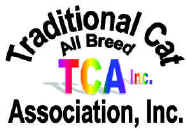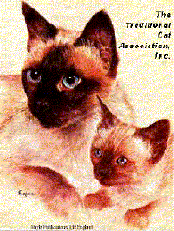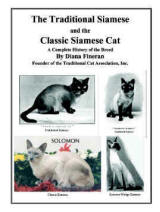|
TRADITIONAL HONEY BEAR © ®
CAT FAQs
HISTORY - PERSONALITY -
HEALTH
Copyright © Trademark ® Diana Fineran, January 2, 2007
HISTORY
Considerable mythology is connected with the beginning of
the Traditional Honey Bear. Supposedly it was scientifically created in a
laboratory by blending “selected genetic material”, (sperm?) from a male skunk
and deposited it into a female Persian domestic cat. During the same heat cycle,
the Female Persian was then bred to a male cat of unknown origin and given to a
cat breeder. The resulting kittens were born silver and turned black later with
stripes along the back, underside and head. The breeder in-bred one male kitten
to Persian females for seven generations (“The line can breed for seven
generations, using one father.”), until it was announced pure Honey Bears were
produced.
All of this being quit foggy and scientifically
un-documented, has passed into lore and legend for people to believe or dis-believe.
Personally, I’m sure the Traditional Honey Bear is a
Traditional Ragdoll that comes only in the tabby colors. In order for animals
to breed and reproduce characteristics from each other, they must be of the same
species! In my opinion a Skunk/Persian cross would result in a cat with sinus
problems that smelled bad!
The Traditional Honey Bear name came about due to the cat’s
characteristic of flattening their bodies and splaying their legs out to the
side, against a cool floor surface during hot weather. They then resemble a
bear rug!
PERSONALITY
It is the Traditional Honey Bear’s personality that caused
TCA, INC. to step up and preserve it for the future. Filled with a fun spirit,
good nature, curiosity, calmness, gentleness, affection, intelligence, and an
endearing personality, they love to be held and handled. They will flop in your
arms, love attention and are eager to please. In unfamiliar surroundings they
may be shy and hide for a while, but quickly change to a friend for life once
they become comfortable. They adjust well to other pets, seldom showing signs
of aggression. They would rather run than fight and seldom scratch or bite.
Not as vocal as some cat breeds, many do not purr or meow.
Often they are compared to dogs or children in their ways.
They follow the owner around, are trainable, using the dog training technique of
positive reinforcement, and lavish praise. They thrive on love and attention and
are eager to please.
Their strong desire to be involved with everything
happening in their home, the Traditional Honey Bear will always be around to
watch you in your endeavors. Their kitten like eagerness is retained through
adult hood too. Some may be a bit clumsy, but their flexibility helps them
avoid harm.
Blessed with an incredibly sweet disposition, the
Traditional Honey Bear certainly is a “honey” of a cat!
HEALTH
As a long haired cat, their coat does adapt to seasonal
weather, even though they are an indoor cat. Only an occasional mat is found
and must be easily removed when caught early. Daily brushing and monthly claw
clipping is needed to keep them in their prime. They are a very healthy breed.
|

 The
Traditional Cat Association,
Inc.©1987®TM
Official Website
The
Traditional Cat Association,
Inc.©1987®TM
Official Website